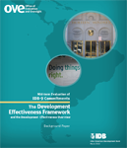IDB-9: The Development Effectiveness Framework and Overview
Date
Mar 2013
The Inter-American Development Bank (IDB or Bank) has worked hard to increase its capacity to report on results. The importance of this issue is reflected in many of the requirements that stem from the Ninth General Capital Increase (IDB-9) process. The IDB-9 Agreement mandates that the IDB report on the results of its projects through an enhanced Development Effectiveness Framework (DEF). It requires that the Bank revise the Development Effectiveness Matrix (DEM) as a tool for assessing evaluability in projects; define a minimum threshold for the evaluability score; strengthen the role of the Operations Policy Committee (OPC) to ensure minimum evaluability standards; strengthen the tools for project monitoring and results reporting to provide more useful information; and report on results annually in the Development Effectiveness Overview (DEO). The DEO is also supposed to report on the findings of impact evaluations and on the recommendations of evaluations of the Office of Evaluation and Oversight (OVE). Many of these requirements have been implemented, and most of those not yet implemented are expected to be finalized soon. Though it is still early in the process, the effectiveness of implementation of the DEF to date appears positive, with some challenges remaining. The DEM for sovereign-guaranteed (SG) projects has been effectively implemented, while the DEM for non-sovereign-guaranteed (NSG) projects is still a work in progress. The focus of OPC meetings on evaluability has increased, though evaluability issues in NSG operations were not identified. The Progress Monitoring Report (PMR) for SG projects has been implemented and is being revised to address some of the challenges it still faces. One significant issue is the lack of integration across these various tools, which appears to limit the usefulness of the PMR system. Finally, the new Project Completion Report (PCR) has not yet been launched but is under preparation. It is critical that it be launched soon, as it is a key part of the Bank's results architecture for SG projects. The DEO is not yet fulfilling its mandate to report on the Bank's overall development results. The DEOs to date have been effective primarily in highlighting and discussing selective areas of Bank activity. Some of the weaknesses of the DEO result from the incomplete implementation of the DEF, including the absence of reliable PCRs and the failure of the NSG DEM to measure evaluability. In addition, the DEO does not explain the reasons for selecting the cases presented and discussed in the analysis of the Bank¿s priority sectors, and the impact evaluations promised are not followed up in later editions. Finally the DEO has not to date had an analysis of the economic rates of return of projects approved in the year of reference or a discussion of OVE recommendations, though the latter is expected in 2013. Moving forward, the Bank should complete the implementation of the DEF and continue to refine the tools that are already in place. To make the most of these tools, it is important to ensure that they are integrated and to promote a culture of planning for results and a willingness to report on problems and failures as well as successes. The DEO should seek to focus on lessons learned from both success and failure and to serve more as a tool for accountability.



